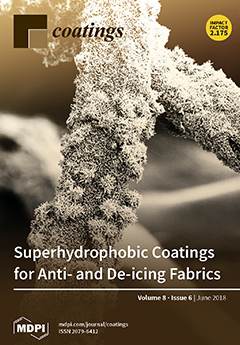In order to evaluate the electrochemical behavior of nano-ZrO
2 particles in the co-deposition process, revealing the electrocrystallization mechanism and electrodeposition parameters of composite coatings, cyclic voltammetry (CV), chronoamperometry (CA), and electrochemical impedance spectroscopy (EIS) techniques were used to offer a favorable reference
[...] Read more.
In order to evaluate the electrochemical behavior of nano-ZrO
2 particles in the co-deposition process, revealing the electrocrystallization mechanism and electrodeposition parameters of composite coatings, cyclic voltammetry (CV), chronoamperometry (CA), and electrochemical impedance spectroscopy (EIS) techniques were used to offer a favorable reference for electrochemical studies in an acidic amino sulfonate bath, and the kinetic parameters were calculated by fitting the experimental curves. The CV results suggested that the co-deposition of nano-ZrO
2 particles and matrix metal caused the initial deposition potential of Ni
2+ and Co
2+ to shift to more positive values (−0.80 V vs SCE) while the nano-ZrO
2 inhibited the reduction of H
+ and decreased the cathodic polarization in co-deposition. The electrocrystallization of Ni-Co and Ni-Co-ZrO
2 sedimentary layer were governed by the Scharifker–Hill instantaneous nucleation model, and the nucleation rate of composite coatings was higher at potentials ranging from −1.10 to −1.15 V, and nano-ZrO
2 absorbed on an electrode surface promoted the nucleation/growth of Ni
2+ and Co
2+. However, nano-ZrO
2 particles hindered the nucleation/growth of Ni
2+ and Co
2+ at −1.20 and −1.25 V vs. SCE; the calculated results were consistent with the theoretical analysis of experimental curves. An EIS test indicated that the incorporation of nano-ZrO
2 particles into the matrix did not obviously effect the electric double layer at the electrode/electrolyte interface, but the charged transfer resistance of the composite was decreased in the electrodeposition.
Full article





